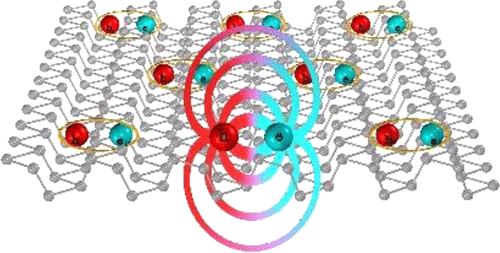当前位置:
X-MOL 学术
›
Acc. Chem. Res.
›
论文详情
Our official English website, www.x-mol.net, welcomes your
feedback! (Note: you will need to create a separate account there.)
Highly Enhanced Many-Body Interactions in Anisotropic 2D Semiconductors
Accounts of Chemical Research ( IF 16.4 ) Pub Date : 2018-04-19 00:00:00 , DOI: 10.1021/acs.accounts.7b00504 Ankur Sharma 1 , Han Yan 1 , Linglong Zhang 1, 2 , Xueqian Sun 1 , Boqing Liu 1 , Yuerui Lu 1
Accounts of Chemical Research ( IF 16.4 ) Pub Date : 2018-04-19 00:00:00 , DOI: 10.1021/acs.accounts.7b00504 Ankur Sharma 1 , Han Yan 1 , Linglong Zhang 1, 2 , Xueqian Sun 1 , Boqing Liu 1 , Yuerui Lu 1
Affiliation

|
Atomically thin two-dimensional (2D) semiconductors have presented a plethora of opportunities for future optoelectronic devices and photonics applications, made possible by the strong light matter interactions at the 2D quantum limit. Many body interactions between fundamental particles in 2D semiconductors are strongly enhanced compared with those in bulk semiconductors because of the reduced dimensionality and, thus, reduced dielectric screening. These enhanced many body interactions lead to the formation of robust quasi-particles, such as excitons, trions, and biexcitons, which are extremely important for the optoelectronics device applications of 2D semiconductors, such as light emitting diodes, lasers, and optical modulators, etc. Recently, the emerging anisotropic 2D semiconductors, such as black phosphorus (termed as phosphorene) and phosphorene-like 2D materials, such as ReSe2, 2D-perovskites, SnS, etc., show strong anisotropic optical and electrical properties, which are different from conventional isotropic 2D semiconductors, such as transition metal dichalcogenide (TMD) monolayers. This anisotropy leads to the formation of quasi-one-dimensional (quasi-1D) excitons and trions in a 2D system, which results in even stronger many body interactions in anisotropic 2D materials, arising from the further reduced dimensionality of the quasi-particles and thus reduced dielectric screening. Many body interactions have been heavily investigated in TMD monolayers in past years, but not in anisotropic 2D materials yet. The quasi-particles in anisotropic 2D materials have fractional dimensionality which makes them perfect candidates to serve as a platform to study fundamental particle interactions in fractional dimensional space.
中文翻译:

各向异性2D半导体中高度增强的多体相互作用
原子薄的二维(2D)半导体为未来的光电子器件和光子学应用提供了许多机会,这是由于2D量子极限处的强光相互作用引起的。与二维块状半导体相比,二维半导体中基本粒子之间的许多体相互作用大大增强,因为其尺寸减小,从而降低了介电屏蔽。这些增强的许多身体相互作用导致形成坚固的准粒子,例如激子,三重子和双激子,这对于2D半导体的光电子器件应用(例如发光二极管,激光器和光学调制器等)非常重要。最近,新兴的各向异性2D半导体,2个,2D钙钛矿,SnS等显示出强大的各向异性光学和电学性质,这与常规的各向同性2D半导体(例如过渡金属二卤化钨(TMD)单层)不同。这种各向异性导致在2D系统中形成准一维(准1D)激子和三子,这导致了各向异性2D材料中更强的许多身体相互作用,这是由于准粒子和尺寸的进一步减小所致。因此减少了介电屏蔽。过去几年,在TMD单层中已对许多人体相互作用进行了深入研究,但在各向异性2D材料中尚未进行研究。各向异性二维材料中的准粒子具有分数维,这使其成为研究分数维空间中基本粒子相互作用的平台的理想候选者。
更新日期:2018-04-19
中文翻译:

各向异性2D半导体中高度增强的多体相互作用
原子薄的二维(2D)半导体为未来的光电子器件和光子学应用提供了许多机会,这是由于2D量子极限处的强光相互作用引起的。与二维块状半导体相比,二维半导体中基本粒子之间的许多体相互作用大大增强,因为其尺寸减小,从而降低了介电屏蔽。这些增强的许多身体相互作用导致形成坚固的准粒子,例如激子,三重子和双激子,这对于2D半导体的光电子器件应用(例如发光二极管,激光器和光学调制器等)非常重要。最近,新兴的各向异性2D半导体,2个,2D钙钛矿,SnS等显示出强大的各向异性光学和电学性质,这与常规的各向同性2D半导体(例如过渡金属二卤化钨(TMD)单层)不同。这种各向异性导致在2D系统中形成准一维(准1D)激子和三子,这导致了各向异性2D材料中更强的许多身体相互作用,这是由于准粒子和尺寸的进一步减小所致。因此减少了介电屏蔽。过去几年,在TMD单层中已对许多人体相互作用进行了深入研究,但在各向异性2D材料中尚未进行研究。各向异性二维材料中的准粒子具有分数维,这使其成为研究分数维空间中基本粒子相互作用的平台的理想候选者。











































 京公网安备 11010802027423号
京公网安备 11010802027423号